How to Read Like a Doctoral Student
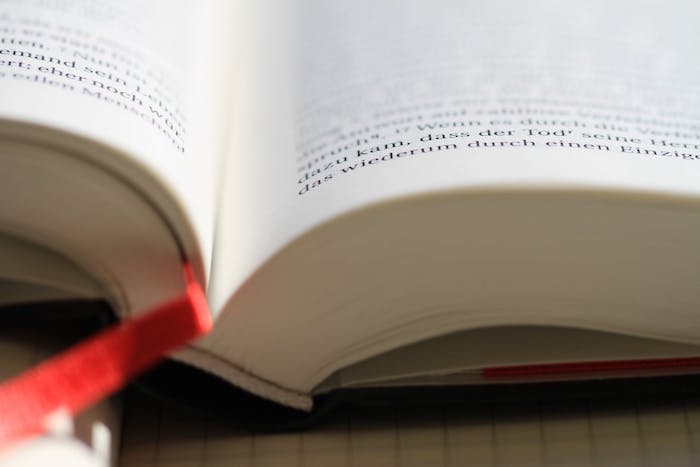
In his wildly popular 1986 book, All I Really Need to Know I Learned in Kindergarten, author Robert Fulghum reminds readers of simple lessons they once learned but may have forgotten, lessons such as share everything, wash your hands before you eat, and of course, flush. During the past year, I’ve experienced the opposite of what Fulghum describes. Some things I’ve done my entire post-kindergarten life—that I thought I was pretty good at—I’ve had to relearn.
Things like reading and writing.
You see, I’ve just recently finished the first year of a business doctorate and the program forced me to revisit reading and writing skills I’ve always taken for granted.
In a recent twitter thread, I described my admittedly still brief experience in the program:
1/ Coming from industry to work on a business doctorate, many friends ask first, "Why the hell would you do something like that?" Then, they follow with, "So what do you do in a doctorate?" #phdchat
— Kevin P. Taylor (@ktaylor) May 30, 2018
When friends, family, and people in my industry hear that I am pursuing a doctorate in my forties after a career in technology and entrepreneurship, they fall into one of two camps.
Firstly, there are the people who subconsciously savor the sight of a train wreck. These are the people who slow down and lean over to get a better view when passing a three-car pileup on the highway.
From these dear friends and relatives, I hear comments such as, “Wow, kudos to you but I’m so done with school. No way! So, what does it involve, anyway?”
When I tell the second group of friends and family about my educational plans and the “interesting” research projects I am pursuing, I’ll catch a sparkle in eye.
From these folks, I hear comments like, “I would love to do that someday. I almost applied to a Ph.D. program after undergrad but, you know, I had student loans to pay off. So, what does it involve, anyway?”
The short answer is reading, reading, and more reading.
In this blog post, I’ll share five techniques I’ve learned over the past year while learning how to read as a doctoral student, where I’m required to read, retain, and recall large amounts of complex information.
If you must absorb and make use of large quantities of information (everyone?), then you too will benefit from learning the powerful—but not easy—reading techniques that follow.
This is not the reading you learned in kindergarten.
5 Advanced Techniques to Learn How to Read More Effectively
In the past month, I’ve read 575 pages from scientific journals and academic book chapters in electronic format (either a PDF or a Kindle book). I’ve read several hundred additional pages in paper books.
This is a normal reading load in my program.
The reading doesn’t always go smoothly. Many time over the past year—usually after 10-12 hours of binge reading—my eyes would quiver and water.
At one point I could no longer focus my eyeballs on words. Imagine that feeling when trying to do your…let’s imagine…50th push-up but your arms just stop taking orders from your brain.
So, how do doctoral students read so much dense material and keep it all straight? Scientific articles are not reading cliffhangers. No Harry Potter or The Hunger Games 1 for doctoral students.
And, just as important, how do doctoral students retain and recall everything we’ve read?
During the first few months of my doctoral studies, it was clear I was coming into the program ill-equipped for the amount and type of reading that was expected. The techniques that follows are what I found work best for me.2
Read with a Purpose in Mind
Do you read novels at work?
Probably not, if you’re like most people. You have job to do, for crying out loud. But, when you read like a doctoral student, reading is your job. You must treat it as such.
Keeping that in mind, every time I crack open a book or journal article, I do so with a clear purpose in mind.
I read to accomplish a predefined goal. When done, I don’t linger in the material, I move on. If you don’t take anything else away from this article, remember to read for a specific purpose.
Let’s look at some reasons I might need to read something. Depending on your job, you may come up with a different list.
Purpose for Reading
- Survey what already exists.
- When I start a new research topic, I likely don’t know much about it. I won’t be sure what research questions3 to ask. What has already been discussed and researched? Who is writing and working in the area? When doing this type of survey-level reading, I stay at 30,000 feet. My goal is to understand terminology, categorization, schools of thought, common research methods, seminal works, and prolific authors.
- Determine the current thinking.
- The world evolves over time and scientific knowledge is no exception. The state-of-the-art knowledge a year ago could now be refuted, retracted, or otherwise out-of-favor. Assuming I’ve developed a specific research question on a topic and understand the area broadly, I’ll want to delve into the specifics—detailed information on hypotheses, constructs, phenomena, models, methods, and theories.
- Find gaps.
- If I have a general understanding of a topic and know the current state of knowledge, I’ll want to learn what gaps exist in the current knowledge about a topic (e.g. the effect of passion on launching new ventures). If I have a specific question in mind, has it already been answered? If it has, am I convinced the answer is plausible? Or, are there reasons to doubt (e.g. are currently accepted conclusions built on shaky research or are the conclusions over-generalized)? If my research question hasn’t been answered yet, this could point to a possible research opportunity.
- Learn new methods.
- Sometimes I need to acquire a new skill. For instance, I may need to test the reliability of a set of survey questions or I may need to perform a statistical analysis that I haven’t used before. In what ways have previous researchers already done the same things? (Precedent is important in science.)
Your method of reading should be driven by its purpose. To gather the right level of information with the least time investment, I read in layers.
Read in Layers
Imagine a journal article or academic book is an onion. Both consist of layers of material. And, both can make you cry.
Thinking of reading material as a series of layers to be peeled focuses my time and energy on only the layer that will best serve my purpose at that moment.
Layer One Scanning
The first layer of a piece is its outer shell. Layer one scanning reveals the most basic information. I use that information to decide if it is relevant to my purposes.
The output of layer one scanning is simply a list of relevant pieces I will later read for layer two survey-level information.
For a journal article,4 the first layer is comprised of just the title and abstract.
Together the title and abstract should contain enough information to decide if the article warrants closer examination.
The first layer of a book includes its title, cover material, table of contents, and any relevant book reviews.
If I believe a piece could be useful to my research, I move it to a second layer reading to understand its background, conclusions, and key points.
Layer Two Reading
Layer two reading is the scientific equivalent of CliffNotes™.
The second layer of a journal article is comprised of the abstract, introduction, and conclusion, also known as the AIC. In layer two reading, I quickly read the abstract, introduction and conclusion and lightly skim the method and analysis sections and all tables and figures.
A book’s second layer consists of its preface, introduction, table of contents, chapter introductions and conclusions, and, again, any figures and tables. In addition, I skim the body of each relevant chapter looking for important nuggets. This will give me a fair approximation of a book’s contents with only a few hours investment.
Layer Three Reading
The third layer of a piece represents its nitty-gritty details.
A third layer reading is a full, detailed examination of the entire piece (article or book). At this level of reading, I engage deeply with the material, reading it front to back, closely examining every figure and table, every claim or finding, every step of its narrative.
Clearly, I reserve third layer reading to pieces that are highly relevant to my topic of interest.
While reading each progressive layer of material, I highlight and annotate. In other words, I engage the author in a conversation via the margins of the piece.
Converse with the Author
Active learning increases information retention and recall. In fact, systems such as the SQ3R Method provide a well-trodden approach to active reading.
My version of active reading includes reading in layers (action) and conversing with the author (another action) at increasing levels of detail. Conversing with the author requires both systematically highlighting text and scribbling comments in the margins.
The deeper I read, the more I converse. The conversation should heat up as I develop a more nuanced view of the piece.
Highlight and Annotate
When I read in layer two, focusing on the abstract, introduction, and conclusion, I highlight the most important points in yellow, usually less than one sentence per paragraph. Orange highlighting designates supporting points, while sky blue marks any references I need to further examine.
In addition to structured highlighting, I write brief notes in the margins, questions, cross-references, etc. I specifically annotate the following:
- Purpose of the piece,
- Gaps addresses,
- Gaps not addressed,
- Sketch out the theoretical model,
- Hypotheses,
- Sample and methods used (survey, experiment, etc.),
- Findings, and
- Obvious inconsistencies, questions, or cross references to related material.
Make Up Your Own Shorthand
I use my own homemade shorthand:
- “RI” is for a research idea,
- “Q” is for a question,
- Empty Square is a to-do item (i.e. a checkbox),
- “Gap” identifies a gap in the literature,
- “RQ” is the piece’s research question.
Here is an example of an article I recently read at layer three for a research methods class:
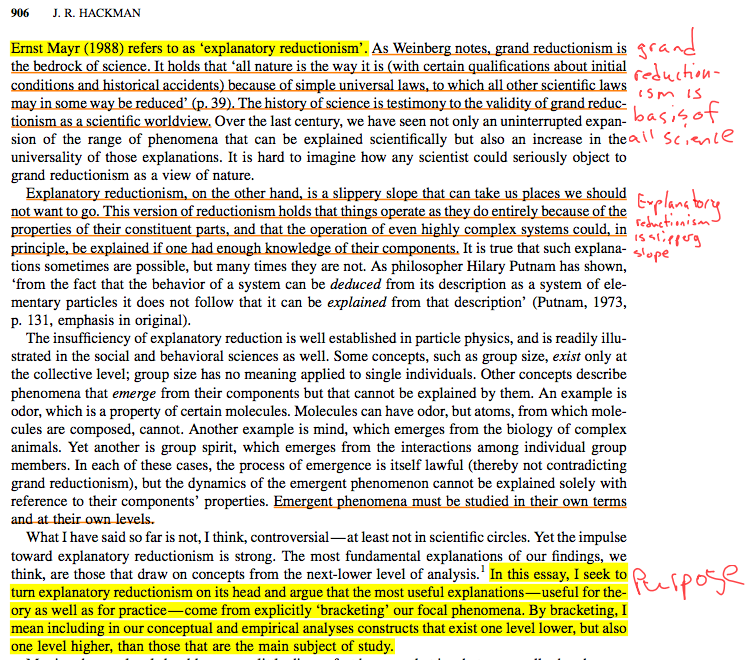
Consume instead of Preserve
If you are anything like me, you love books. You probably have stacks of books sitting near your chair as you read this. Like me, you might even have some in protective covers.
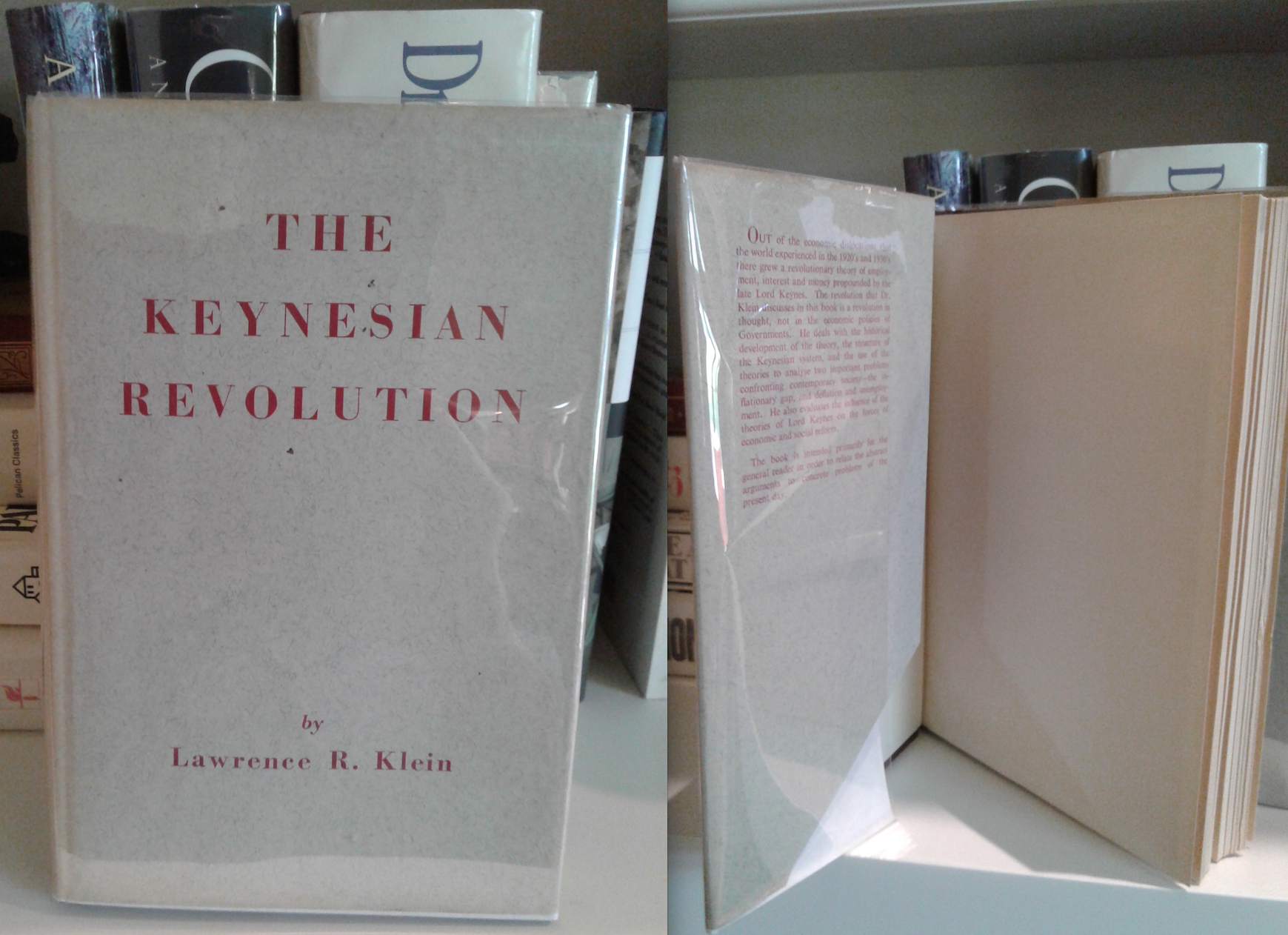
But when I read to learn, I consume my material. I destroy books and journal articles with highlighters and red pens.
Yes, deface, mutilate.
Here’s a recently defaced PDF:
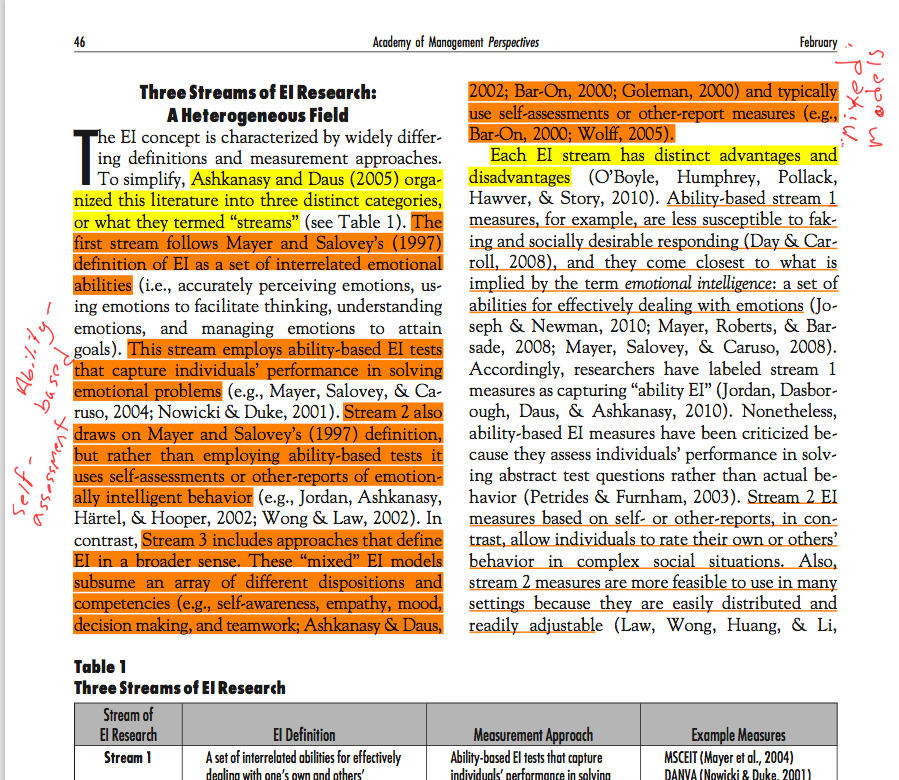
I should be clear, though. I only deface books in electronic format or books still in print that I can easily replaced.
If a book is out-of-print or borrowed (e.g. from a library), I never mark in it but instead use plenty of sticky notes.
The point is that purposeful reading of a book or article is important work. Work often requires consuming resources.
The book or journal article is there to serve my purpose.
Summarize and Synthesize the Material
After spending time reading, highlighting and annotating an article or book, it is time to put the new information in context and make sure it is available for future recall.
Unlike the ancients and their method of loci5 people today are not trained to retain and recall vast quantities of detailed information using memory alone.
Instead of trying to remember everything using my sketchy-at-best memory, I use a structured process of summarizing and synthesizing new information. How in-depth I do this depends on the reading layer in which I’m operating.
Layer One
During layer one reading I’m simply trying to collect and organize relevant sources for later use. During my searches, if a piece looks interesting based on its title and abstract, I simply import the reference into Zotero67, my citation management software.
After a layer two reading, I will have highlighted and annotated the most important parts of the book or article. Immediately after reading—or better, while reading—I put notes into a structured Google Sheet called a “conceptual synthesis worksheet.”
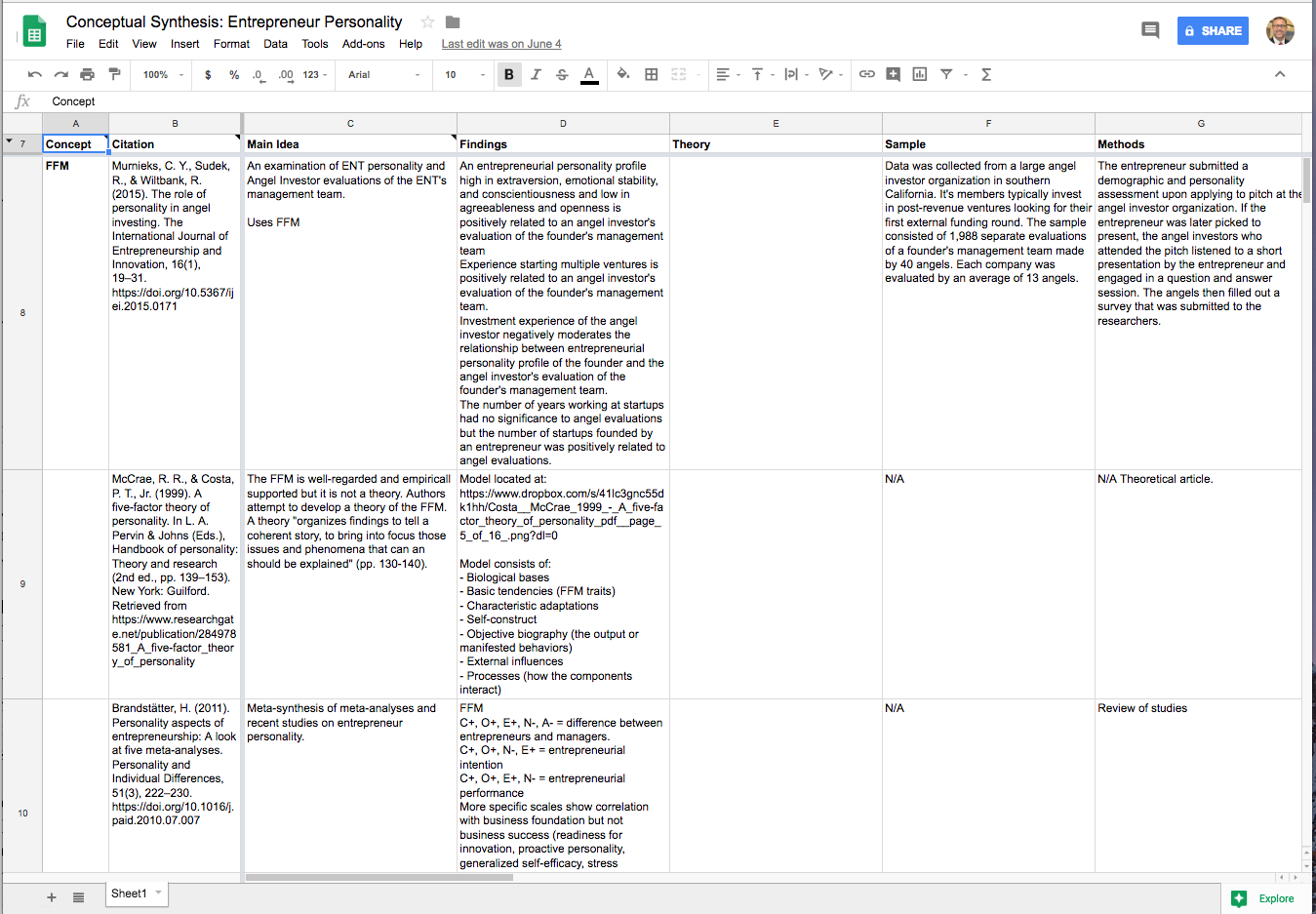
I create one conceptual synthesis worksheet for each important keyword or concept in my research topic. These worksheets also correspond to the subfolders in my Zotero citation management software. For example, a current project has worksheets and Zotero subfolders for the following topics: Entrepreneur Personality, Angel Decision-Making, Angel Motivation, and Angel Investor Characteristics.
Layer Two
After layer two reading, in addition to populating a row in a conceptual synthesis worksheet, I often write (meaning sometimes write) a prose summary and synthesis of the piece in a structured “Journal Reading Summary Form.” In the JRSF, I address the following questions:
- What is the aim of the research? Specifically, what “big picture” practical question is
highlighted and what more focused research question is addressed? - Why should anyone care?
- What major theory(ies) are used to support the work?
- What methods are used to test the study’s hypotheses or research questions?
- What are the major findings/conclusions?
- What are the most important contributions of the research?
Early in my doctoral program, a professor handed out these questions to the class. But, there are several “how to read a journal article” documents floating around the Internet with similarly structured note-taking forms.
Layer three reading helps develop a deep understanding of a piece. In my experience, this only occurs after attempting to synthesizing the material with other research I’ve read and with my own thoughts.
Layer Three
Synthesizing material during level three reading requires developing an understanding of how the piece relates to the work of others and the work that I am doing. This is where I really question the material, think critically. Question everything: assumptions, methods, sample, validity, and reliability. Where are the contradictions? Do the conclusions make sense in the real world? What are the flaws (all research is flawed) and how could those flaws be overcome in future research?
I use one of two ways to synthesize material during layer three reading (deep reading). If a piece is not immediately needed, I write a stand-alone memorandum and store it in Zotero.
If I need the synthesis for a current project, I might also create a shortened version of the memorandum and include it in the project’s annotated bibliography, if it exists. In any case, I also save the AB entry in Zotero for future use.
Go Read Like a Doctoral Student
Whether you are a doctoral student, an entrepreneur, or engage in other knowledge work, the skills to efficiently filter through large amounts of information and purposefully capture and use just what you need can be a competitive advantage.
For example, I follow over a thousand blogs in my Feedly account. I check my account once a week or so and there are always hundreds of new posts.
I use similar techniques to what we’ve explored in this article to quickly scan at layer one, survey-level read at layer two and, rarely, dive deep at layer three. Blog posts and web pages that pass my layer one scan go into an Instapaper folder until I have time to read it at layer two.
My challenge to you today is, think about what we’ve discussed in this article. How can you use these techniques to stop reading…all…the…words…in a book or article and just read to accomplish your specific purpose?
What information organization system can you set up this week using Zotero, Evernote, Feedly, Instapaper, Google Drive, etc. to organize and manage the information you consume and want to recall?
Robert Fulghum, the author of All I Really Need to Know I Learned in Kindergarten shared many useful lessons from kindergarten. But, even he assumed reading was a given. But reading at an advanced level, for a purpose, takes a systematic approach. Now you have the necessary tools to do just that.
- Well, unless you happen to be a scholar researching Harry Potter or The Hunger Games.
- The techniques are not my invention and have been shamelessly borrowed from other smart people.
- Good research questions are ones that investigate something interesting, that are valuable either practically or theoretically, and that can possibly be answered given the researcher’s resources, time frame, and skill set.
- Journal articles follow consistent formats. Quantitative articles often contain an abstract, introduction, method, analysis, discussion, and conclusion section.
- Also know as memory palaces.
- Zotero has a powerful “Connector,” or browser plugin, that makes it easy to import sources directly from web pages and library databases.
- Each of my writing projects might use 5-8 Zotero subfolders to organize the material. You could alternatively use another citation database, or even Evernote, Google Drive, or Dropbox for organization.

Thanks a lot for this article, so helpful as a new PhD candidate. I especially liked the Layer reading method and conceptual synthesis worksheet.
Thanks, Sarah — good luck with your PhD.
This is really a helpful article,I have gotten a couple of nuggets from it,I plan to use them during my researches.Glad I stumbled on this article.
Really helpful article. I know I am replying multiple years later, but I have a question. How do you do all this and still read multiple journal articles? It takes me several hours just to finish a single article by reading through, so I can barely get to the next article I have to read. What enabled you to do all of this layered reading and writing for one paper that you read and still be able to read other papers without it taking millenia?
Scott, thanks for the questions. In short, the point of the layers is to save myself time. I only read papers at layer 2 if layer 1 indicated it is relevant to my project. If not, I’ve just saved myself a lot of time. Layer 3 papers are the ones I spend the most time with but those are the most important papers and deserve the time.
If you are taking several hours to read each paper, let me reassure you that it will get faster, especially if you use a triage system like the one I describe here. As you get to know a particular literature well, you will skim much of the front end of a paper because it’s repeating what you already know. You’ll be looking for the results and any anomalies or issues with the methods.
Good luck in your journey.
Wow I read this and got inspired, I did not feel anxious about the idea of reading until my eyes hurt or felt some discomfort. Wonderful writing! This is an article most PhD students need to see.
Thank you for this information. The conceptual synthesis worksheet will be very helpful to current and future research and assignments.
You’re welcome!
Kevin- This is awesome and incisive work. Love the practicality. Well Done!
Thanks for reading!
Brain,
Glad you enjoyed the post. Thanks for the recommendation for “Digital Paper.” I’m eager to learn more techniques. I’ve read the skimming, scanning, extracting terminology the book description mentions but it looks like it is more extensive than what I’ve seen previously. I’ll check it out.
Great writeup Kevin!
I wanted to pass on a related reading, “Digital Paper” by Andrew Abbott (Sociology prof @UChicago), which is about the art of scholarly library research. He has 7 stages (“design, search, scanning/browsing, reading, analyzing, filing, and writing”), which has some similarities to how you outlined your process in this post.
http://www.press.uchicago.edu/ucp/books/book/chicago/D/bo18508006.html